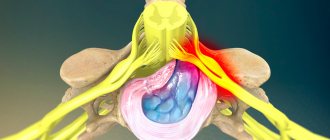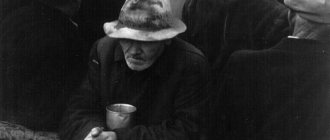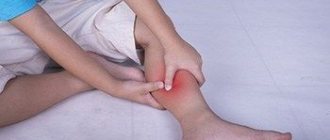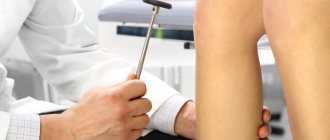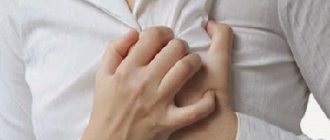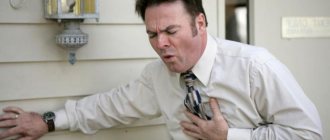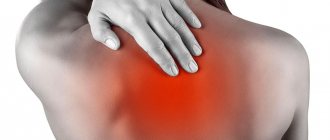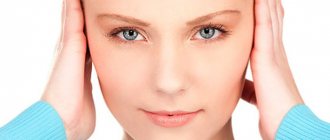To the main symptoms of panic attacks (F41, ICD-10) refers to repeated attacks of severe anxiety, unpredictable in nature, independent of the situation or circumstances. As a rule, an attack of panic attack is accompanied by rapid heartbeat and chest pain, up to the fear of dying from cardiac arrest, a feeling of lack of air, nausea, states of depersonalization and derealization, fear of losing control over oneself and going crazy.
It is important to distinguish between the signs of panic attacks and attacks of normal anxiety. Anxiety is a negatively colored emotion, a premonition that is uncertain regarding the nature of expected events. The causes of anxiety, unlike specific fears, are not objective. In other words, anxiety helps to avoid potentially unwanted situations and their consequences. It becomes the cause of actions that determine a favorable vector of events in an alarming situation.
As for a panic attack, it is a sudden, causeless attack of pronounced anxiety, accompanied by fear and various somatic symptoms. In other words, the clinical signs of panic attacks must necessarily be accompanied by a type of anxiety in which it is impossible to establish the cause of the fear. The nature of such anxiety cannot be explained by the person himself, even at its peak, except as fear for his own life and sanity.
Symptoms and signs of panic attacks
In the clinical picture of the disease, the leading symptoms and signs of panic attacks are strong fear that cannot be rationalized, disturbances in the functioning of the respiratory organs and cardiovascular system, and other phenomena of a vegetative nature. As a rule, the attack occurs instantly and lasts about 15–30 minutes.
The incidence of panic attacks varies from moderate (F41.00, ICD-10) to severe (F40.01, ICD-10). Moderate episodic paroxysmal anxiety corresponds to - from 4 attacks over a distance of 28 days; severe - at least 4 attacks in 7 days at a distance per month.
As a rule, the individual picture of an attack includes the following symptoms and signs of panic attacks:
- cardiopalmus;
- chest discomfort;
- tingling in the heart area;
- rise in blood pressure;
- feeling of lack of air;
- labored breathing;
- dizziness;
- sweating;
- “waves” of heat and cold;
- nausea;
- diarrhea (sometimes).
Objectively, during an attack, those around you can record a change in the color of the skin, sweating, a rise in blood pressure, a high pulse rate, difficulties with coordination of movements, and tremors. However, both the person himself and the people around him usually mistake the symptoms of panic attacks for signs of a heart attack or stroke (especially at the onset - the first attack of PA).
In some cases, with a weak mental constitution (low threshold of resistance to stress factors), a severe panic attack can lead to loss of consciousness. With repeated attacks of PA, anticipatory anxiety develops quite quickly, expanding the range of negative experiences with the fear of expecting an attack. In addition, agoraphobia and restrictive behavior may appear in the clinical picture.
Rice. 1. The mechanism of a panic attack.
Symptoms of panic attacks in women
Clinical practice shows that women are more susceptible to episodic paroxysmal anxiety than men. The symptoms of panic attacks in women are not much different from the signs of the “male” version of the disease. However, they still affect the health and adjust the life of an adult woman.
The main symptoms of panic attacks in women include:
- menstrual irregularities;
- other endocrine disorders affecting reproductive function;
- increased risk of developing neurotic and depressive disorders;
- alcoholism according to the female type.
In addition, the development of the disease can cause disruption in a woman’s functioning in the family, even leading to the risk of divorce proceedings. Indirectly, the disease inevitably affects both men and children, becoming the cause of “secondary” psychopathology, including developmental disorders of the mental apparatus in children.
Symptoms of panic attacks in men
Symptoms of panic attacks in men can radically change a person’s life, masking the disease under character traits, lifestyle, or unusual creeds. Outside of marriage, it is quite difficult for such a person to maintain a relationship; in marriage - to preserve the family or relationships in it, to create favorable conditions for raising children, the healthy development of their mental apparatus.
Typical symptoms of panic attacks in men that affect quality of life include:
- problems with potency;
- risk of developing severe depression with suicidal tendencies;
- rapid alcoholization, interest in surfactants.
If the picture of the disease is dominated by depressive tendencies, alcoholism or addiction to psychoactive substances quickly develops, and there is a high risk of suicidal tendencies. Most successful attempts to commit suicide during the course of the disease are observed in men.
Symptoms of panic attacks in teenagers and children
As a rule, severe symptoms of panic attacks in adolescents can be detected between the ages of 7-10 years. First of all, they manifest themselves in an unusual deterioration in the well-being of children, a decrease in mood and activity. Within an educational institution, such a child may become a victim of bullying or violence from classmates, fall behind in academic performance, and withdraw into himself.
Symptoms of panic attacks in adolescents that occur against a background of increased anxiety or fear attacks include:
- decreased tone;
- fast fatiguability;
- frequent headaches;
- gastrointestinal disorders;
- increased sweating;
- cardiopalmus;
- pain in the heart area;
- dyspnea.
Unfortunately, symptoms of panic attacks in children are not detected in a timely manner. Parents can search for a long time for the true reason for the deterioration of their child’s well-being, visiting doctors of various specializations year after year, ignoring treatment for panic attacks by a child psychiatrist or neuropsychiatrist. However, having learned to cope with attacks of PA, such a child becomes “adapted” only externally, maintaining psychopathology in potency. Having entered adulthood, such children have a high probability of relapse of the disease and, consequently, its development.
Rice. 2. Types of reaction to stress and panic attack.
Flow options
Panic attacks come in the following types:
- Large (expanded), which are manifested by 4 or more symptoms.
- Minor – accompanied by 4 or less typical manifestations.
While some patients report only 1-2 panic attacks throughout their lives, some of them complain of regular panic attacks. The interictal period can proceed in different ways. If the dysfunction of the autonomic nervous system is insignificant, then the patient generally feels healthy. In more severe cases of panic disorder, symptoms such as shortness of breath, arterial hyper- or hypotension, gastrointestinal disorders, headache, etc. are observed even between attacks.
Over time, patients who frequently experience panic attacks and have characteristic personality traits develop restrictive behavior. They are afraid of a repetition of the attack, so they try to avoid situations and places in which previous episodes occurred. This may result in a fear of driving this or that type of transport, or a fear of being alone at home.
Types of attacks with panic attacks
Panic attacks are individual in nature. They differ in the symptoms and conditions that predominate in the clinical picture. Conventionally, attacks are divided into six types, unfolding as the disease progresses (from symptomatic poor attacks to extensive phobic avoidance with secondary depression):
- typical - autonomic disorders and undifferentiated phobias predominate;
- phobic - the picture of autonomic disorders is dominated by subjective fears that arise in situations that are dangerous only in the opinion of the person suffering from PA;
- affective - strong depressive tendencies, painfully low mood, negative irritability are observed;
- senestopathic - unpleasant and frightening somatic sensations of an unknown nature are emphasized (the person cannot specifically describe the painful condition);
- hyperventilation - there are pronounced breathing disorders (rapid and/or deep breathing, attacks of apnea, paresthesia and muscle pain);
- conversion - tendencies of a hysterical nature, senestopathic reactions dominate, panic is expressed insignificantly or is absent altogether;
- depersonalization-derelization - feelings of unreality of the world around us and a person’s perception of himself come to the fore.
Nocturnal panic attacks are different from nightmares and are not associated with images that appear in dreams in the second half of the night, in the REM phase - these are the dreams that a person remembers. Their occurrence is usually observed in the first half of the night, from 12 to 4 am. Similar to the “daytime” version, panic attacks at night are characterized by a sudden attack of severe fear for life (fear of respiratory arrest, heart failure) or unbearable anxiety.
Therapy methods
It is possible to eliminate panic attacks only by carrying out therapy for cervical osteochondrosis and achieving stable remission. An integrated approach to the treatment of this degenerative pathology is practiced. Therapy begins with the use of conservative methods, and if they are ineffective, surgery is performed.
Medicines
In the treatment of cervical osteochondrosis, nonsteroidal anti-inflammatory drugs, muscle relaxants, chondroprotectors, and ointments with a warming effect are used.
To relieve panic disorders, it is necessary to use other means.
| Clinical and pharmacological group of drugs for the relief of panic attacks | Names of medicines |
| Tricyclic antidepressants | Clomipramine, Amitriptyline, Imipramine, Nortriptyline, Maprotiline, Mianserin, Tianeptine |
| Serotonin uptake inhibitors | Sertraline, Paroxetine, Fluoxetine, Fluvoxamine, Cipramil |
| Benzodiazepines | Clonazepam, Alprozalam, Lorazepam, Diazepam |
| Sedatives, sedatives | Persen, Novo-Passit, Tenoten, tinctures of valerian, peony, motherwort |
Physiotherapy and gymnastics
In the treatment of cervical osteochondrosis, physiotherapeutic measures are used to improve blood circulation, prevent strangulation of the vertebral artery and the appearance of a state of oxygen starvation of the brain. Patients can be prescribed 5-10 sessions of the following procedures:
- UHF therapy;
- magnetic therapy;
- laser therapy;
Treatment of cervical spine pathologies with laser.
- galvanic currents;
- shock wave therapy;
- electrophoresis, ultraphonophoresis with glucocorticosteroids, chondroprotectors, B vitamins, solutions of calcium salts;
- applications with ozokerite or paraffin;
Neck applications made of ozokerite and paraffin.
- balneotherapy with therapeutic mud and mineral waters.
One of the leading methods of reducing the likelihood of panic attacks is daily exercise therapy and gymnastics. The physical therapy doctor draws up a schedule of classes and selects exercises individually for the patient. Patients are also recommended swimming, Nordic walking, and water aerobics.
Swimming is useful for osteochondrosis of any location.
How is treatment performed with folk remedies?
Infusions of medicinal plants can be effective for panic disorders. In home therapy for osteochondrosis, St. John's wort, peony, oregano, valerian, motherwort, lemon and peppermint, and thyme are used to eliminate its neurological manifestations. To prepare the infusion, pour a glass of boiling water over a teaspoon (without a slide) of dry medicinal raw materials and leave for 40-60 minutes. Strain, take 100 ml for anxiety and unmotivated restlessness.
Herbal collection.
Read on the topic: Treatment of cervical osteochondrosis with folk remedies.
Risk factors for developing symptoms and signs of PA
There are risk factors that precede the onset of panic attacks. These include the mental constitution of a person with an emphasis on general negative affectivity - with a tendency to “get stuck” on negative emotions, to give a negative assessment to almost everything that happens in life. Childhood, the nature of the relationship between parents, and parenting style play an important role in the formation of such an outlook on life.
“Genetic” factor and symptoms of PA
The occurrence of symptoms of panic attacks is influenced by growing up in an unfavorable family environment, where the child witnesses quarrels and violent conflicts between parents. Psychological and physical abuse in childhood, including sexual abuse, is also a risk factor for developing signs of panic attacks. This also includes such strong stress factors as parental abandonment of the child, deprivation of parental rights, and their premature death.
The emotional deprivation of a child with a significant person (son - mother, daughter - father), who provides a sense of security, is the cause of dissonance between sensory and emotional experience. A sure sign of such a situation in the family is overprotection, which cannot replace love for the child. Growing up in such a family creates the preconditions for the development of symptoms of panic attacks due, for example, to the repression of an anxious state, including the fear of being abandoned and, consequently, of dying, and the lack of understanding of its (fear) true causes (unconscious constant anxiety is the norm for such a person).
Clinical statistics also point to a “genetic” factor in the appearance of signs of panic attacks . For example, in children whose mothers suffered from PA, the risk of developing the disease increases significantly. It should be understood that the genetic factor here means not only the possibility of transmitting psychopathology by inheritance, but also its acquisition as a child copying an “anxious response”, or a combination of both. In particular, if parents suffer from mood disorders (eg, anxiety, depression, bipolar disorder), there is also a possibility of symptoms and signs of panic attacks in the child.
“Social” factor and signs of PA
Among the risk factors that provoke the development of symptoms of panic attacks in adulthood are lifestyle and traumatic events that negatively affect a person’s mental health:
- active smoking;
- alcohol abuse;
- drug use;
- side effects of medications;
- surgical intervention under general anesthesia;
- life in constant stress;
- interpersonal, family conflicts;
- divorce, other difficult life situations;
- chronic somatic diseases;
- stay in a military conflict zone;
- road accident;
- being in the zone of man-made and natural disasters;
- death of a loved one.
Among the somatic diseases, the presence of which potentiates the risk of symptoms of panic attacks, it should be noted bronchial asthma, chronic bronchitis, chronic obstructive pulmonary disease, arrhythmia, angina pectoris, hypertension, mitral valve prolapse, hypo- and hyperthyroidism, epilepsy, somatoform disorders, OCD, PTSD .
Diagnosis of the disease
The main thing is to diagnose cervical osteochondrosis in the early stages, when full-scale deformation of the intervertebral discs and changes in the vertebrae have not yet occurred. The main method remains radiography of the spine, however, in more serious cases, a CT or MRI of the cervical spine will be required. Such a more in-depth study allows us to determine a possible bulging intervertebral disc, a hernia, or other pathology, such as a tumor.
In this regard, preference is almost always given to MRI, which makes it possible to diagnose not only the presence of changes in the vertebrae, but also to determine the cause of the pain syndrome, which is not available to other examination methods. The use of this diagnostic method in neurosurgery is especially significant. The clearly visible nerve roots, passing vessels and intervertebral discs allow for minor surgical interventions. The only drawback is that the research is expensive.
In biochemical blood tests, the main attention is paid to the coagulation system and microcirculation (the movement of blood through the smallest vessels). What is this connected with? With increased blood clotting, its movement slows down significantly. In addition, it becomes so viscous that it will be difficult to reach the brain through the narrowed cervical vessels. Hence cerebral ischemia, which manifests itself as already mentioned neurological disorders. Another feature of viscous blood is its increased ability to form blood clots, which threatens complete or partial blockage of the vessel.
List of used literature
1. ROP. "Panic disorder."
2. ROP. "Panic disorder in adults."
3. Francesetti D. “Gestalt therapy in the unity of clinical and social contexts.”
4. Natolochnaya O., Cherkasov A. “Panic attacks as a syndrome of the 21st century.”
5. Shitov E.A., Shustov D.I. "Neurotic and somatoform disorders."
6. Shapiro E. “The Panic Attack workbook.”
7. Neil A., Bourdeau D., Kitchen K., Joseph-Massiah L. “Anxiety disorders.”
Share
Share
Main conclusions
Panic attacks with cervical osteochondrosis are a serious condition that worsens the mental and physical condition of the patient. It is not so easy to cure the pathology, so you should consult a doctor when the first suspicious symptoms appear. After a thorough diagnosis, the neurologist will determine treatment tactics. Therapy should be comprehensive: medications, physiotherapy, massage, manual manipulation, lifestyle correction. To avoid relapses of the disease, you need to lead a moderately active lifestyle, avoid stress, limit the consumption of coffee and alcohol, take a hot shower every day, sleep on an orthopedic mattress, and eat right.
Cost of treatment in our clinic
| Service | Price | |
| Ambulatory treatment | ||
| Psychiatrist consultation | 4 500 ₽ | |
| Consultation with a psychotherapist | 4 500 ₽ | |
| Psychodiagnostics extended | 7 000 ₽ | |
| Consultation with a psychiatrist at home | 6 000 ₽ | |
| Treatment in hospital | ||
| Delivery to hospital | For free | |
| Standard room | 7 700 ₽ | |
| 3-bed superior room | 10 600 ₽ | |
| 2-bed superior room | 13 700 ₽ | |
| 1 local VIP chamber | 19 000 ₽ | |
| Doctor's appointment 2 weeks after discharge | For free | |
Prevention of osteochondrosis of the cervical spine
Regular physical activity and exercises to strengthen the muscular corset of the back effectively maintain the normal condition of the spinal structures. Daily gymnastics and monitoring the position of the neck and back during the working day help normalize blood circulation and relieve excess stress on individual segments of the spine.
It is also necessary to monitor the diversity of your diet and prevent excess weight. A massage course, which should be repeated 2-3 times annually, helps to activate metabolic processes and eliminate muscle spasms.
